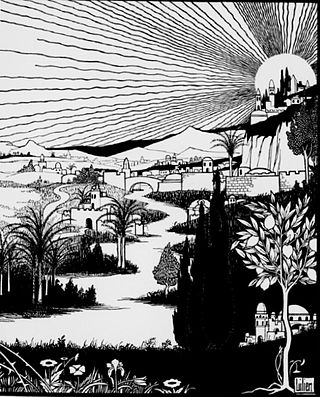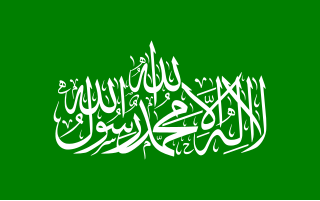
Jerusalem is a city in the Southern Levant, on a plateau in the Judaean Mountains between the Mediterranean and the Dead Sea. It is one of the oldest cities in the world, and is considered holy to the three major Abrahamic religions—Judaism, Christianity, and Islam. Both the State of Israel and Palestine claim Jerusalem as their capital. Israel maintains its primary governmental institutions there, and Palestine ultimately foresees it as its seat of power. Neither claim is widely recognized internationally.

The Temple in Jerusalem, or alternatively the Holy Temple, refers to the two religious structures that served as the central places of worship for Israelites and Jews on the modern-day Temple Mount in the Old City of Jerusalem. According to the Hebrew Bible, the First Temple was built in the 10th century BCE, during the reign of Solomon over the United Kingdom of Israel. It stood until c. 587 BCE, when it was destroyed during the Babylonian siege of Jerusalem. Almost a century later, the First Temple was replaced by the Second Temple, which was built after the Neo-Babylonian Empire was conquered by the Achaemenid Persian Empire. While the Second Temple stood for a longer period of time than the First Temple, it was likewise destroyed during the Roman siege of Jerusalem in 70 CE.

Moriah is the name given to a mountainous region in the Book of Genesis, where the binding of Isaac by Abraham is said to have taken place. Jews identify the region mentioned in Genesis and the specific mountain in which the near-sacrifice is said to have occurred with "Mount Moriah", mentioned in the Book of Chronicles as the place where Solomon's Temple is said to have been built, and both these locations are also identified with the current Temple Mount in Jerusalem. The Samaritan Torah, on the other hand, transliterates the place mentioned for the binding of Isaac as Moreh, a name for the region near modern-day Nablus. It is believed by the Samaritans that the near-sacrifice actually took place on Mount Gerizim, near Nablus in the West Bank.
Al-Quds is an Arabic name for Jerusalem.

Zion is a placename in the Hebrew Bible, often used as a synonym for Jerusalem as well as for the Land of Israel as a whole.

The Jebusites were, according to the books of Joshua and Samuel from the Hebrew Bible, a Canaanite tribe that inhabited Jerusalem, called Jebus before the conquest initiated by Joshua and completed by King David, although a majority of scholars agree that the Book of Joshua holds little historical value for early Israel and most likely reflects a much later period. 1 Chronicles 11:4 states that Jerusalem was known as Jebus before this event. The identification of Jebus with Jerusalem is sometimes disputed by scholars. According to some biblical chronologies, the city was conquered by King David in 1003 BCE.

Mount Zion is a hill in Jerusalem, located just outside the walls of the Old City. The term Mount Zion has been used in the Hebrew Bible first for the City of David and later for the Temple Mount, but its meaning has shifted and it is now used as the name of ancient Jerusalem's Western Hill. In a wider sense, the term Zion is also used for the entire Land of Israel.
Maqdisi is an Arabic nisba referring to a Jerusalemite. It is derived from Bayt al-Maqdis, an Arabic name for Jerusalem, by way of the Hebrew Beit HaMikdash, the Temple in Jerusalem. Today, the common Arabic name of Jerusalem is al-Quds.

Eilat Mazar was an Israeli archaeologist. She specialized in Jerusalem and Phoenician archaeology. She was also a key person in Biblical archaeology noted for her discovery of the Large Stone Structure, which she surmised to be the palace of King David.

The city of Jerusalem is sacred to many religious traditions, including the Abrahamic religions of Judaism, Christianity and Islam which consider it a holy city. Some of the most sacred places for each of these religions are found in Jerusalem, most prominently, the Temple Mount/Haram Al-Sharif.
Bayt, also spelled bayit, bayyit, bait, beit, beth, bet, etc., may refer to:

Q-D-Š is a triconsonantal Semitic root meaning "sacred, holy", derived from a concept central to ancient Semitic religion. From a basic verbal meaning "to consecrate, to purify", it could be used as an adjective meaning "holy", or as a substantive referring to a "sanctuary, sacred object, sacred personnel."

Temple denial is the claim that the successive Temples in Jerusalem either did not exist or they did exist but were not constructed on the site of the Temple Mount, a claim which has been advanced by Islamic political leaders, religious figures, intellectuals, and authors.

The Walls of Jerusalem surround the Old City of Jerusalem. In 1535, when Jerusalem was part of the Ottoman Empire, Sultan Suleiman I ordered the ruined city walls to be rebuilt. The work took some four years, between 1537 and 1541. The walls are visible on most old maps of Jerusalem over the last 1,500 years.

The siege of Jebus is described in passages of the Hebrew Bible as having occurred when the Israelites, led by King David, besieged and conquered the Canaanite city of Jerusalem, then known as Jebus. The Israelites gained access to the city by conducting a surprise assault, and Jebus was subsequently installed as the capital city of the United Kingdom of Israel under its initial name as the City of David.

Aknaf Bait al-Maqdis was a Syrian Palestinian rebel group active during the Syrian Civil War.
Jerusalem is an ancient city in West Asia.
Abu Bakr Muhammad ibn Ahmad al-Wasiti was the preacher (khatib) of al-Aqsa Mosque in 1019–1020, the year he wrote a treatise entitled Concerning the (religious) status of Jerusalem, better known as Fada'il Bayt al-Muqaddas, also spelled Fada'il al-Bayt al-Maqdis, literally "Merits/Virtues of Jerusalem".












